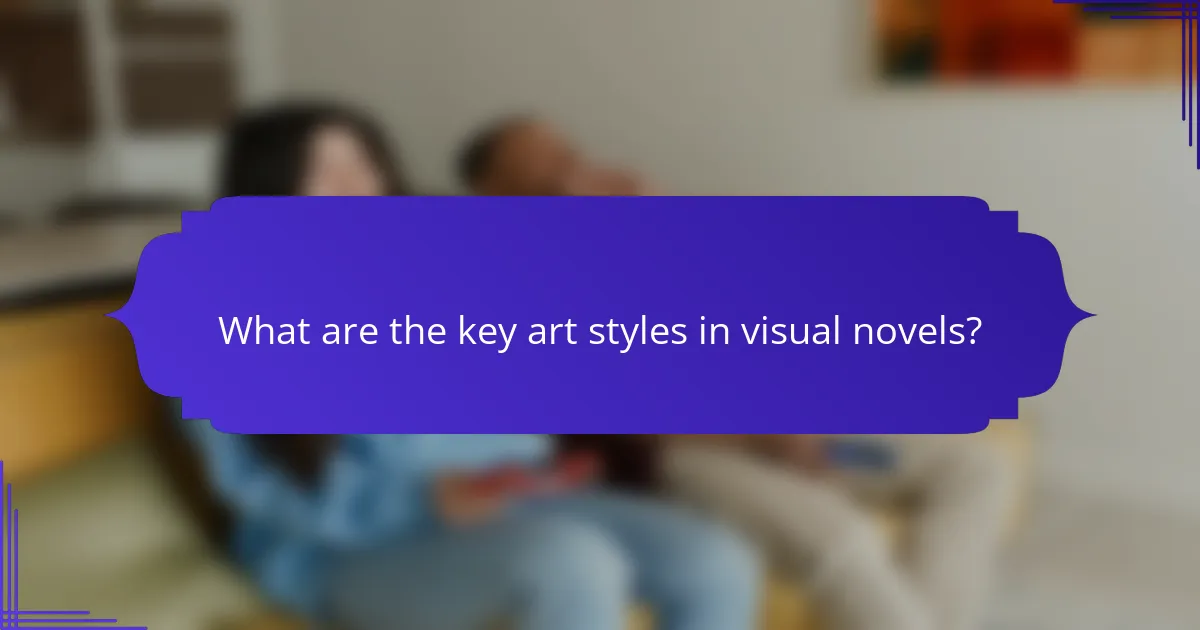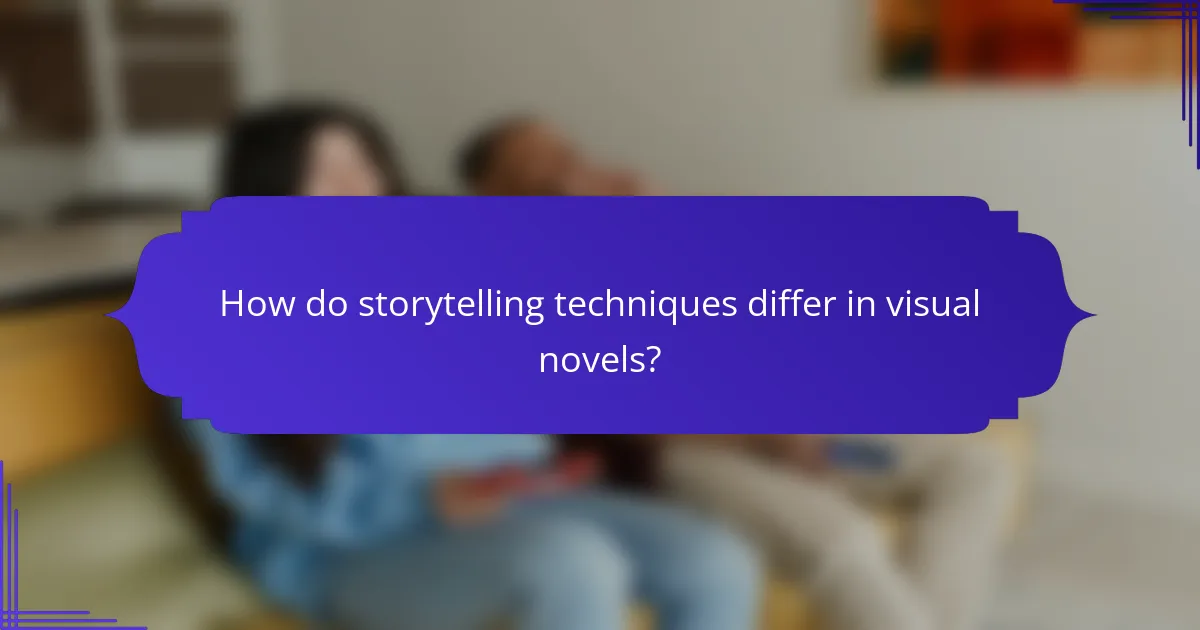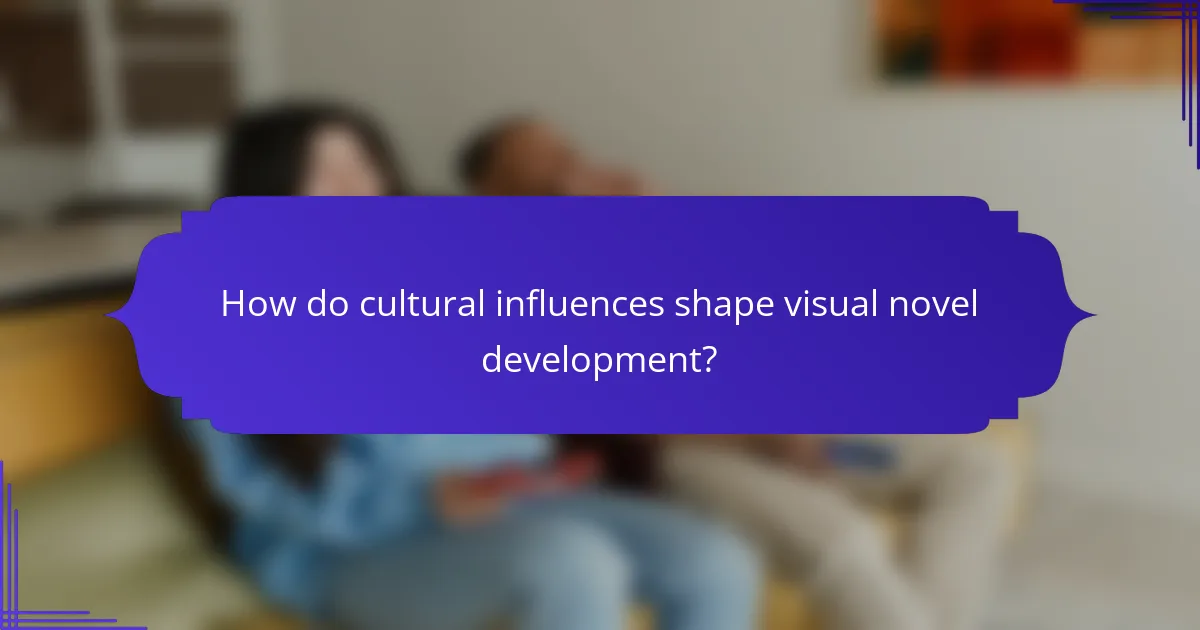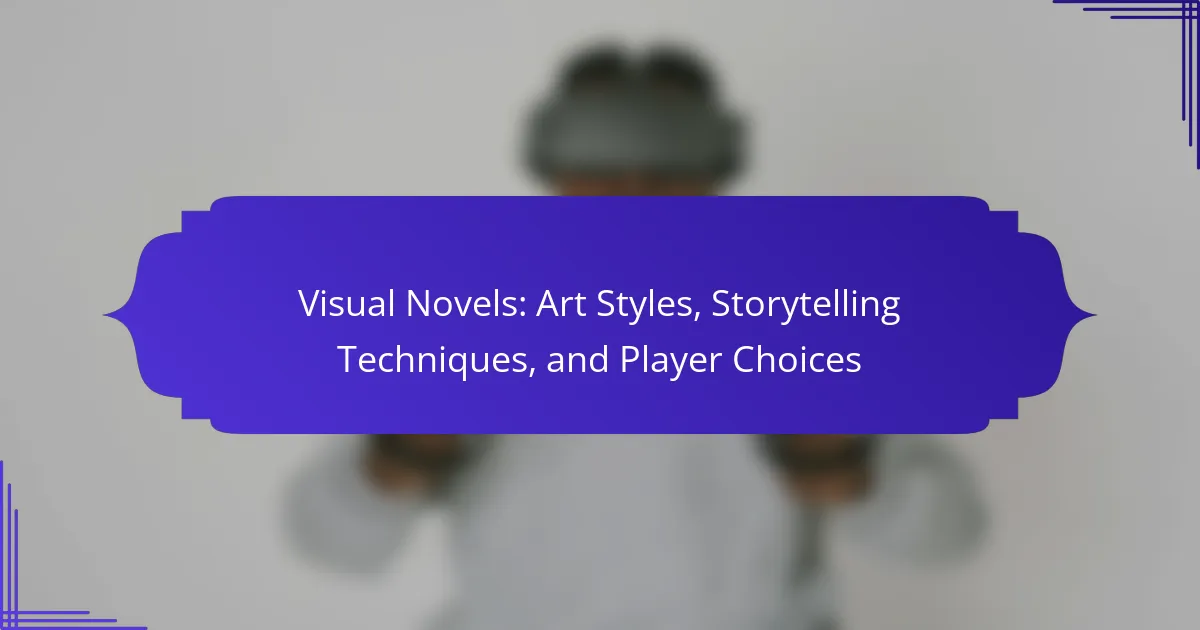Visual novels offer unique storytelling experiences through diverse art styles, engaging player choices, and cultural influences. Explore the impact of anime-inspired, realistic, and minimalist art on narrative depth. Discover how branching storylines enhance player agency and emotional connections. Understand the role of cultural context in shaping visual novel development and player engagement.

What are the key art styles in visual novels?
Visual novels feature diverse art styles that enhance storytelling and player engagement. Key styles include anime-inspired, realistic, and minimalist art. Anime-inspired art is vibrant and expressive, often characterised by exaggerated features and colourful palettes. Realistic art aims for lifelike representations, creating immersive environments. Minimalist art focuses on simplicity, using fewer details to convey emotions effectively. Each style influences player choices and narrative depth, enriching the overall gaming experience.
How do art styles influence player immersion?
Art styles significantly enhance player immersion in visual novels by shaping emotional connections and narrative engagement. Distinctive art styles create unique atmospheres, influencing how players perceive characters and storylines. For example, vibrant colours may evoke joy, while darker palettes can instil tension. The visual representation of characters also affects player choices, as appealing designs can lead to stronger emotional investment. Additionally, art styles can signal genre, guiding player expectations and enhancing the overall storytelling experience.
Which art styles are most popular in North America?
The most popular art styles in North American visual novels include anime, realistic, and cartoonish aesthetics. Anime styles dominate due to their vibrant colours and expressive characters. Realistic styles appeal to players seeking immersive storytelling, while cartoonish designs attract a younger audience with their playful visuals. Each style influences player choices and engagement in the narrative.
What role does character design play in storytelling?
Character design significantly enhances storytelling by shaping player perception and emotional connection. Well-crafted characters embody traits that resonate with players, influencing their choices and engagement. Unique attributes, such as visual styles and backstories, create memorable interactions. This depth enriches the narrative, making the player’s journey more immersive and impactful.

How do storytelling techniques differ in visual novels?
Storytelling techniques in visual novels often emphasise player agency and emotional engagement. Unlike traditional narratives, visual novels utilise branching storylines that adapt based on player choices, enhancing immersion. Unique attributes include visual art styles that complement the narrative tone, such as anime-inspired graphics or realistic illustrations. Furthermore, the integration of music and sound effects plays a rare but impactful role in shaping the storytelling experience, influencing player emotions and decisions.
What narrative structures are commonly used in visual novels?
Visual novels commonly use branching narratives, linear structures, and multiple endings. Branching narratives allow players to make choices that significantly affect the storyline. Linear structures provide a straightforward path, emphasising character development and plot progression. Multiple endings enhance replayability by offering different outcomes based on player decisions. These techniques create an engaging storytelling experience unique to visual novels.
How do branching storylines affect player choices?
Branching storylines significantly enhance player choices by providing multiple narrative paths. This interactivity allows players to influence character development and plot outcomes, creating a more immersive experience. Visual novels utilise these branching paths to engage players emotionally, fostering investment in the story. The unique attribute of player agency in visual novels differentiates them from linear storytelling mediums, making each choice impactful. As a result, players often experience a sense of ownership over the narrative, leading to varied gameplay experiences.
Which storytelling elements enhance emotional engagement?
Visual novels enhance emotional engagement through character development, immersive storytelling, and impactful art styles. Strong character arcs create connections, while narrative choices allow players to influence outcomes. Artistic elements, such as colour palettes and visual motifs, evoke specific emotions, enriching the overall experience.

What are the most impactful player choices in visual novels?
Player choices in visual novels significantly impact narrative direction, character relationships, and endings. Choices can lead to multiple story branches and unique experiences for players. For instance, key decisions often determine character fates or unlock specific story arcs, enhancing replayability. The emotional weight of choices can create deeper connections to characters and themes, making player agency a core element of visual novels.
How do choices shape the narrative experience?
Choices significantly shape the narrative experience in visual novels by influencing plot direction and character development. Player decisions create branching paths that lead to multiple endings, enhancing engagement. This interactivity allows players to invest emotionally in outcomes, making their choices feel impactful. Unique art styles complement storytelling techniques, further immersing players in the narrative.
What are the consequences of player decisions on story outcomes?
Player decisions in visual novels significantly shape story outcomes, influencing character arcs and plot developments. Choices can lead to multiple endings, altering relationships and narrative paths. This interactivity enhances engagement, allowing players to experience unique storylines based on their decisions. The branching narratives reflect the root attribute of player agency, while specific outcomes can serve as unique attributes that distinguish one playthrough from another.

How do cultural influences shape visual novel development?
Cultural influences significantly shape visual novel development by affecting art styles, storytelling techniques, and player choices. Different cultures bring unique aesthetics and narrative structures that resonate with their audiences. For instance, Japanese visual novels often emphasise emotional storytelling and character development, reflecting cultural values of connection and empathy. In contrast, Western visual novels may prioritise gameplay mechanics and player agency, aligning with individualistic cultural traits. Additionally, cultural themes and tropes can influence character design and plot progression, creating a diverse landscape of visual novels that cater to various cultural sensibilities. This interplay enhances the immersive experience for players, making cultural context a vital element in visual novel creation.
What themes resonate with players in different regions?
Visual novels resonate with players through diverse themes influenced by regional cultures and preferences. In Japan, themes often revolve around romance and personal growth, reflecting societal values. In Western regions, narratives may emphasise adventure and moral choices, appealing to individualism. In contrast, players in Southeast Asia often appreciate folklore-inspired stories, integrating local myths and traditions. These thematic preferences shape art styles and storytelling techniques, enhancing player engagement and choice.
How do localization efforts impact storytelling?
Localization efforts significantly enhance storytelling by making narratives more relatable to diverse audiences. They adapt cultural references, dialogue, and character backgrounds, enriching the player’s experience. This approach respects unique attributes of different cultures, enhancing emotional connections. As a result, players engage more deeply, leading to varied choices that reflect their own cultural contexts.

What unique features set apart specific visual novels?
Unique features of visual novels include diverse art styles, innovative storytelling techniques, and dynamic player choices. These elements create immersive experiences that differentiate each title.
Art styles vary significantly, ranging from hand-drawn illustrations to 3D graphics, influencing the overall aesthetic and emotional impact. Storytelling techniques often incorporate branching narratives, allowing players to make choices that shape the plot. This interactivity enhances engagement and replayability.
Player choices can lead to multiple endings, providing a unique attribute that encourages exploration. Some visual novels also integrate puzzles or mini-games, adding layers to the gameplay experience. Overall, these unique features contribute to the distinctiveness of each visual novel.
Which visual novels have innovative gameplay mechanics?
Innovative gameplay mechanics in visual novels include branching narratives, real-time decision making, and interactive puzzles. Titles like “Danganronpa” and “428: Shibuya Scramble” exemplify these mechanics, enhancing player engagement through unique storytelling techniques and player choices. “Danganronpa” integrates murder mystery elements with social simulation, while “428: Shibuya Scramble” uses live-action footage to create immersive experiences. These innovations redefine how stories unfold, making player agency a central aspect of gameplay.
What rare narrative techniques are found in acclaimed titles?
Acclaimed visual novels often employ rare narrative techniques such as non-linear storytelling, where players influence plot progression through choices. These techniques enhance immersion and emotional engagement. Unique attributes include metafictional elements, where the game self-references its medium, and interactive storytelling, allowing players to shape character arcs. Rarely, some titles incorporate innovative art styles that visually represent player decisions.

What best practices should developers consider for visual novels?
Developers should focus on engaging storytelling, diverse art styles, and meaningful player choices. Prioritise narrative structure to maintain player interest. Use a variety of visual styles to enhance emotional impact. Implement branching storylines that allow for player agency and replayability. Regularly gather player feedback to refine gameplay mechanics and narrative elements.
How can developers balance art and storytelling effectively?
Developers can balance art and storytelling by integrating visual styles that complement narrative depth. Effective visual novels use distinct art styles to evoke emotions and enhance player engagement. For instance, vibrant colours may convey joy, while muted tones can reflect somber themes. Storytelling techniques such as branching narratives allow players to influence outcomes, fostering a sense of agency. This interplay between art and narrative creates a cohesive experience that resonates with players, making them feel invested in both the story and its visual representation.
What common mistakes should be avoided in visual novel design?
To avoid common mistakes in visual novel design, focus on clear storytelling, engaging art styles, and meaningful player choices. Prioritise narrative coherence, ensuring the plot flows logically and resonates with players.
Neglecting character development can lead to shallow experiences; invest in well-rounded characters with distinct personalities. Overcomplicating choices may confuse players; instead, offer clear and impactful decisions that shape the story.
Inconsistent art styles can detract from immersion; maintain a cohesive visual theme throughout. Lastly, failing to playtest can result in overlooked issues; gather feedback early to refine gameplay and narrative elements.
